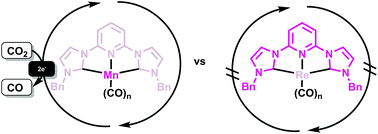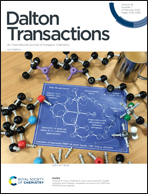Metalloradical intermediates in electrocatalytic reduction of CO2 to CO: Mn versus Re bis-N-heterocyclic carbene pincers†
Abstract
This work examines the relative reactivities of ReI and MnI tricarbonyl pyridine-2,6-bis-N-heterocyclic carbene pincers M(CO)3CNCBnX (M = Re, Mn and X = Cl and Br) towards catalysis for the electrochemical conversion of CO2 to CO. Unlike prior well-studied group VII catalysts, Mn(CO)3CNCBnX is extraordinarily active, while the new Re(CO)3CNCBnX complex surprisingly does not exhibit catalytic response. DFT calculations shed light on this puzzling behavior and show that the redox-active pyridine-2,6-bis-N-heterocyclic carbene ligand facilitates the reduction of the ground-state complexes; however, the extent of electronic delocalization in the reduced intermediates differs in the degree of metalloradical character. The highly-active Mn(CO)3CNCBnX complex proceeds through an intermediate with nucleophilic metalloradical character in which 66% of the unpaired electron spin resides on Mn. In contrast, Re(CO)3CNCBnX reduction proceeds through an intermediate with less metalloradical character in which only 38% of the unpaired spin is localized on Re with the remainder delocalized over the ligand. The energetic penalty of the electron delocalization of an electron on the ligand affects the M–CO bond strengths and related kinetic barriers. We discuss these observations in the context of turnover-enabling effects in CO2 reductions mediated by group VII NHC pincer molecular electrocatalysts.



 Please wait while we load your content...
Please wait while we load your content...